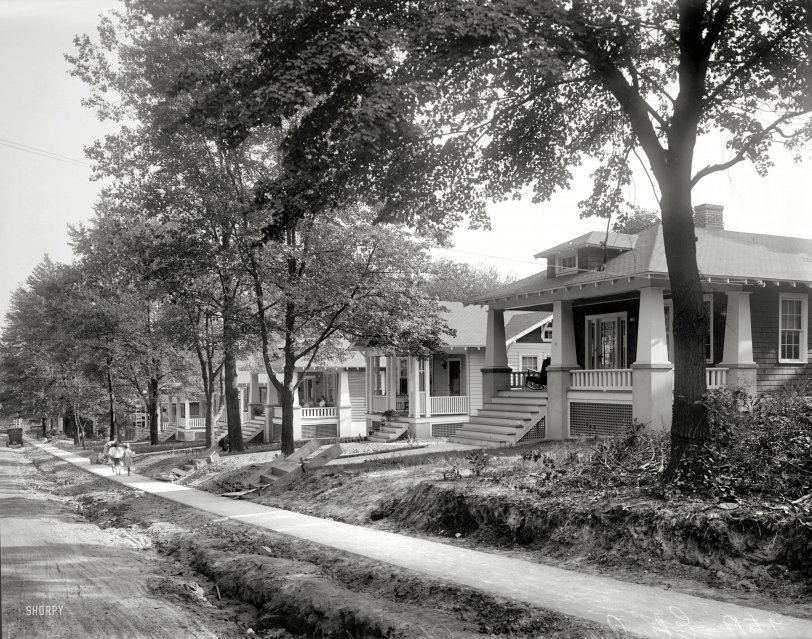


Framed or unframed, desk size to sofa size, printed by us in Arizona and Alabama since 2007. Explore now.
Shorpy is funded by you. Patreon contributors get an ad-free experience.
Learn more.

- Details, Details
- What's that building to the left of the tower?
- Coal Barges
- Bromo-Seltzer
- Inner harbor
- The Basin
- What a headache!
- Giant stepladder?
- Baldwin 62303
- Baldwin VO-1000
- Cold
- No expense spared
- Tough Guys
- Lost in Toyland
- And without gloves
- If I were a blindfolded time traveler
- Smoke Consumer Also Cooks
- Oh that stove!
- Possibly still there?
- What?!?
- $100 Reward
- Freeze Frame
- Texas Flyer wanted
- Just a Year Too Soon
- WWII -- Replacing men with women at the railroad crossing.
- Yes, Icing
- You kids drive me nuts!
- NOT An Easy Job
- I wonder
- Just add window boxes
Print Emporium
Elm Avenue: 1921

Takoma Park, Maryland, circa 1921. "9 to 11 Elm Avenue." National Photo Company Collection glass negative. View full size.
Amazing photo of a beautiful street
aenthal:
Thanks for your comments. Very interesting indeed. It would be wonderful to have one of those Sears homes/garages that you mentioned. As for these homes, this is one of my favorite architectural styles, although in Houston, most of them have been torn down or are now priced out reach for the average Joe.
Milk bottles
At the base of the stairs of the nearest house, it looks like two empties waiting for the milk man.
I have always loved that architectural style of house.
Re: 'Japanese Bungalow'
Always learning something new on 'Shorpy'!
You can see the Asian Influence...now that 'claiborneray' mentioned it.
This design must have been very modern and unusual in that day.
A Brief History of the Home Garage
Though obviously some homes were built with garages and driveways during the 1920's, it was not at all considered a standard home amenity until after World War 2. The early garages tend to be converted carriage houses and in a separate structure than the human living quarters so you didn't have to smell your horses and goats in your kitchen.
My parents have an amazing 2 story 3 car garage in the back yard of their 1920's home. It came with a pot belly type gas stove in one bay (obviously no car could go there) because the original owner had a pet donkey that needed to be kept warm in the winter.
A house I grew up in that was built in 1920 had a Sears Catalog kit garage in its back yard, facing an alley. It was added in 1927 and still had the stock numbers stamped on the boards to help one put it together. No driveway led to it. Only one car could park in it even though it was Sears deluxe 2 car model because the proportions of 1920's garages were tall and narrow like a Model T Ford.
I suspect the homes on this street will get no garages unless the owners separately chose to put some in.
The attached garage in the same building as the home (where zoning laws permit--not all do) becomes a standard amenity with the WW2 GI bill housing boom. But even then, whole communities were built without garages. The Jubilee model of baby boom homes in Levittown Pennsylvania comes with garages. The other models get driveways with carports only.
Thanks to google
and Gordon61 I found the place, most of the houses are still there, and there are no back alleys but now people have added small driveways to their houses. I guess houses were built to last back then.
Street has changed. Houses still there
Looks like the street has changed to Westmoreland Ave.
Round the back
If there was a garage, it was off the alley that ran along the back of the houses, parallel to the street. That put the unsightly cars out of sight of the street.
Variety is the spice of life!
What I find fascinating in this photo is there are 5 different styles of porch posts/pillars which is wonderful to see. So different to subdivision homes these days. From large cylinder columns to large square ones to smaller squares to pyramidal and then trellis style, the houses may be similar in plan, but so much thought has gone into making them seem unique. (And the rocker is facing the porch next door so it seems neighbours were really neighbours then!)
Thanks Shorpy!
I have very fond memories of this stretch of street from when I lived there thirty years ago. Not many of those bungalows remained even then.
Brand New!!
The contractors are not even finished yet, and the new owners are hangin' out on the porch already! New sidewalks and I'm sure curbs and a new road are not too long in this neighborhood's future. But where will the driveways be? It is 1921 and a garage should also be waiting for the family sedan.
The "Japanese" bungalow
My favorite great aunt lived in a larger version of these bungalows, from 1907, and it was one of the most comfortable, light, airy, commodious and well-thought-out houses I have ever been in. She and my great uncle bought it in 1952 or so. About the only real change they ever made was to screen in the front porch at some point.
























On Shorpy:
Today’s Top 5